Does My Child Have Autism?

Introduction: Recognizing the Complexity of Autism
Autism spectrum disorder (ASD) is a developmental condition that affects communication, social interaction, and behavior. Because it presents in many forms and with varying degrees of severity, understanding the early signs, behavioral patterns, and the importance of early evaluation is essential for parents and caregivers. This comprehensive guide explores the indicators of autism across different age groups, screening tools, diagnostic procedures, and the critical role of early intervention in improving long-term outcomes.
Early Signs and Symptoms in Children
What are the early signs and symptoms of autism in children?
Early detection of autism spectrum disorder (ASD) relies heavily on recognizing specific behaviors that may emerge during infancy and early childhood. Around 9 to 12 months, some children may not respond to their name or show limited eye contact, and they might have fewer facial expressions like smiling or showing happiness.
Repetitive behaviors are common early indicators. These can include hand-flapping, rocking, or lining up toys in a specific order. Some children show delays in speech development; by 15 to 18 months, they might not use gestures like pointing or waving, and their speech could be less than expected for their age.
Preference for routines and difficulty handling changes are notable signs. Children may become distressed with minor alterations to their daily routines or environment, often showing strong interests in particular topics or objects.
In terms of social interaction, children with autism often do not engage in pretend play or share interests with others. They might seem unaware of others’ feelings or social cues, which can affect their ability to connect with peers or adults.
Recognizing these early signs is crucial. When parents or caregivers notice such behaviors, consulting healthcare professionals for developmental evaluation can lead to earlier intervention. Early support helps children develop communication, social skills, and adaptive behaviors more effectively.
Understanding the spectrum of autism reveals that symptoms can vary widely, and not every child will show all signs. Nevertheless, awareness of common early behaviors provides an essential step toward supporting children with ASD.
Behavioral Patterns and Characteristics
Children with autism often display a variety of behavioral patterns that can differ widely among individuals. One common feature is the presence of repetitive movements, such as hand-flapping, rocking, pacing, or spinning. These behaviors may serve as self-stimulatory actions for sensory regulation or as a way to cope with overwhelming stimuli.
Unusual body positions and self-injury behaviors are also observed in some children. These can include head-banging, scratching, or biting themselves, often occurring during episodes of distress or sensory overload.
A strong preference for routines characterizes many children with autism. They may become highly upset if routines are disrupted, seeking predictability and consistency in their daily activities. This stress with change can lead to challenging behaviors like tantrums or agitation.
Sensory sensitivities are another hallmark. Children may react intensely to stimuli such as loud sounds, bright lights, certain textures, or tastes. Some may seek sensory input, such as touching or smelling objects excessively, while others may avoid sensory experiences altogether.
Social communication difficulties are central to autism’s behavioral profile. Many children struggle with making eye contact, responding to their name, or interpreting facial expressions and body language. Engaging in reciprocal play—taking turns or sharing interests—might be limited or absent.
Metrics like restricted interests are common. Children may develop intense focus on specific topics or objects, repeating phrases or gestures related to their interests. Emotional responses might seem unusual, with some children exhibiting over- or under-reactivity to stimuli or social situations.
Behaviors tend to intensify during moments of anxiety or stress, serving as coping mechanisms. Overall, these behavioral patterns contribute to the spectrum of autism’s presentation, requiring tailored approaches for support and intervention.
When and How to Seek Professional Evaluation
Recognizing when to seek a professional assessment for autism is crucial for early support and intervention. Parents should consider evaluation if they observe signs such as speech delays, limited eye contact, repetitive behaviors, or social withdrawal. Early indications may include failing to respond to their name, avoiding eye contact, or displaying unusual body movements.
Screening tools like the Modified Checklist for Autism in Toddlers (M-CHAT) and Ages and Stages Questionnaires (ASQ) are recommended at 18 and 24 months. These questionnaires help identify children at risk for autism by assessing behaviors related to communication, social interaction, and repetitive behaviors.
If screening results suggest concerns, reaching out to a multidisciplinary team is the next step. This team typically includes psychologists, developmental pediatricians, neurologists, speech-language therapists, and other specialists trained in autism diagnosis. Their assessment process involves parent interviews, direct observations of the child's behavior, developmental testing, and standardized diagnostic tools like the Autism Diagnostic Observation Schedule (ADOS) and Autism Diagnostic Interview-Revised (ADI-R).
Early diagnosis is especially important; in some cases, children can be assessed as early as 12 months. Detecting autism by age 2 allows access to tailored interventions that significantly improve developmental outcomes. The assessment process may vary depending on the child's age and presenting behaviors, but timely evaluation is essential.
For caregivers, the steps include consulting with their child's primary care provider or pediatrician if concerns arise. These professionals can guide families toward appropriate screening and refer them to specialists for comprehensive evaluations. Acting early can help children develop communication, social, and behavioral skills more effectively and support families in understanding their child's unique needs.
Initial Steps for Parents When Autism Is Suspected
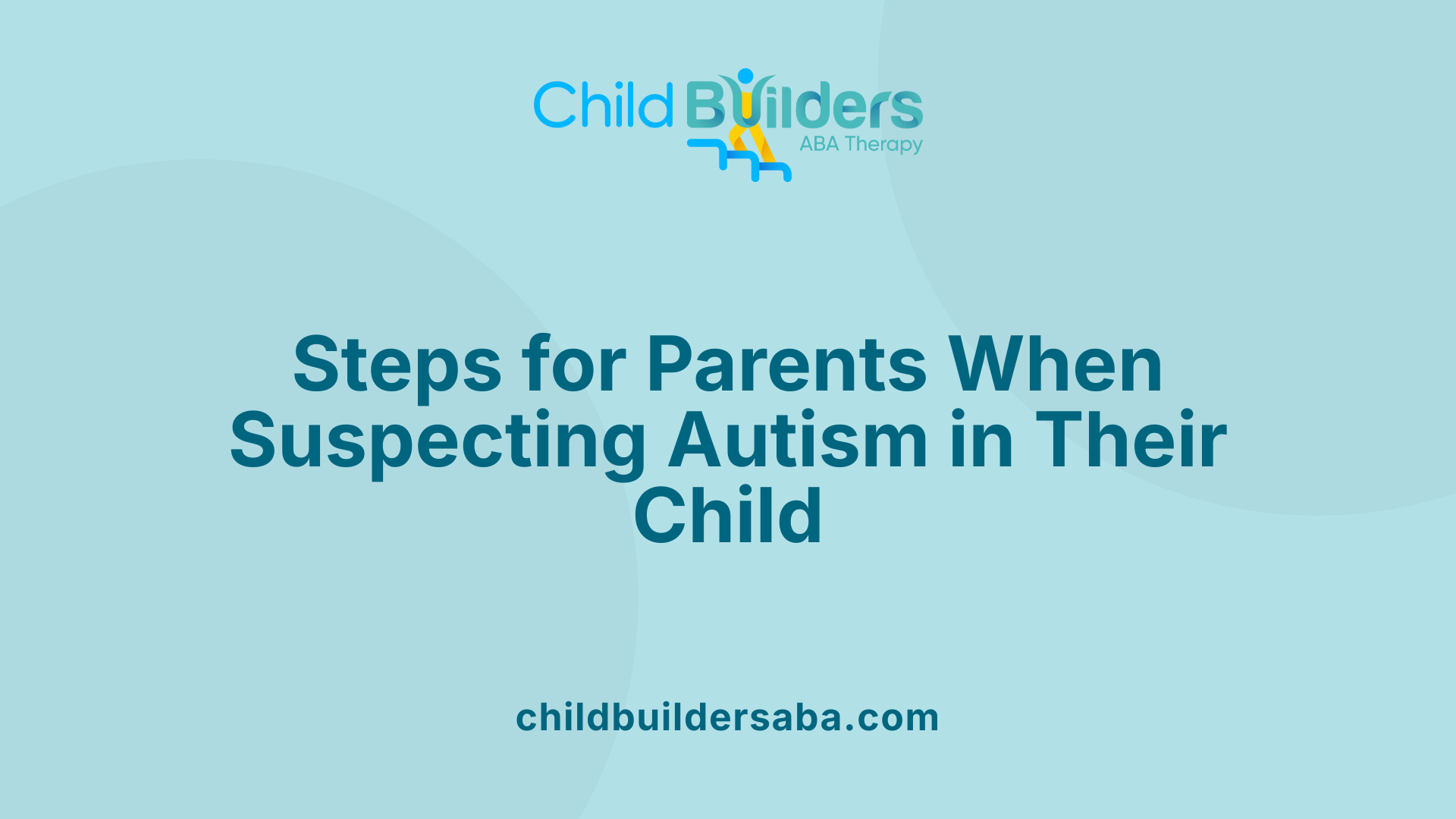
What initial steps should parents take if they suspect their child has autism?
When parents notice signs that may suggest autism, such as limited eye contact, delayed speech, or repetitive behaviors, the first step is to discuss their concerns with their child's pediatrician or a healthcare professional. These professionals can perform initial developmental screenings to assess the child's progress and identify any areas needing further evaluation.
Monitoring early developmental milestones is crucial. Parents should keep an eye on whether their child responds to their name, uses gestures like pointing, or engages in age-appropriate play. If milestones are missed, such as pointing by 14 months or talking in two-word phrases by 24 months, seeking professional advice becomes even more important.
Utilizing screening tools, such as the Modified Checklist for Autism in Toddlers (M-CHAT-R), during routine checkups at 18 and 24 months can help identify early signs of autism. These questionnaires are quick, easy to use, and can flag children who may need a more detailed assessment.
Gathering detailed developmental history, including any medical tests like hearing assessments, helps rule out other causes of delayed development. A thorough history includes noting any regressions in skills, unusual sensory sensitivities, or behaviors like lining up toys or obsessively focusing on objects.
Engagement in early supportive activities can foster development, such as play-based learning, visual supports, or simple communication strategies. Introducing activities that enhance social interaction and communication can be beneficial for all children, especially those at risk.
While waiting for a formal diagnosis, parents should consider accessing early intervention services, such as speech, occupational, or behavioral therapies. These services can start based on screening results and observational assessments, offering support that can significantly improve developmental outcomes.
Finally, collaborating with professionals—such as developmental pediatricians, psychologists, or therapists—to develop a tailored support plan is essential. With early and appropriate interventions, children with autism can make meaningful progress and improve their quality of life.
Screening Tools and Testing Procedures for Autism
What screening tools and testing procedures are used for autism?
Early detection of autism spectrum disorder (ASD) is vital for effective intervention. Screening typically involves parents and healthcare providers working together using validated questionnaires and observational assessments.
In routine pediatric checkups, especially at 9, 18, and 24 or 30 months, pediatricians often utilize parent-completed questionnaires such as the Modified Checklist for Autism in Toddlers (M-CHAT), the Parents’ Evaluation of Developmental Status (PEDS), the Screening Tool for Autism in Toddlers and Young Children (STAT), and the Ages and Stages Questionnaires (ASQ). These tools help identify children who may be showing early signs of ASD.
While these questionnaires are useful for early risk detection, they are not diagnostic on their own. A positive screening result prompts a comprehensive evaluation by specialists. This assessment includes observing the child's behavior, developmental testing, and caregiver interviews.
For diagnosis, professionals rely on structured assessment tools such as the Autism Diagnostic Observation Schedule (ADOS) and the Childhood Autism Rating Scale (CARS). These standardized measures involve direct, detailed observation of the child’s social interactions and behaviors aligned with DSM-5 criteria.
It’s important to understand that there are no medical blood tests or scans currently capable of diagnosing autism. Diagnosis is behavioral, based on observed patterns of social communication, repetitive behaviors, and developmental history.
Early screening helps alert parents and health professionals to the possible presence of ASD, ensuring children receive timely evaluation and access to early intervention programs, which can dramatically improve outcomes.
Differentiating Screening, Assessment, and Diagnosis
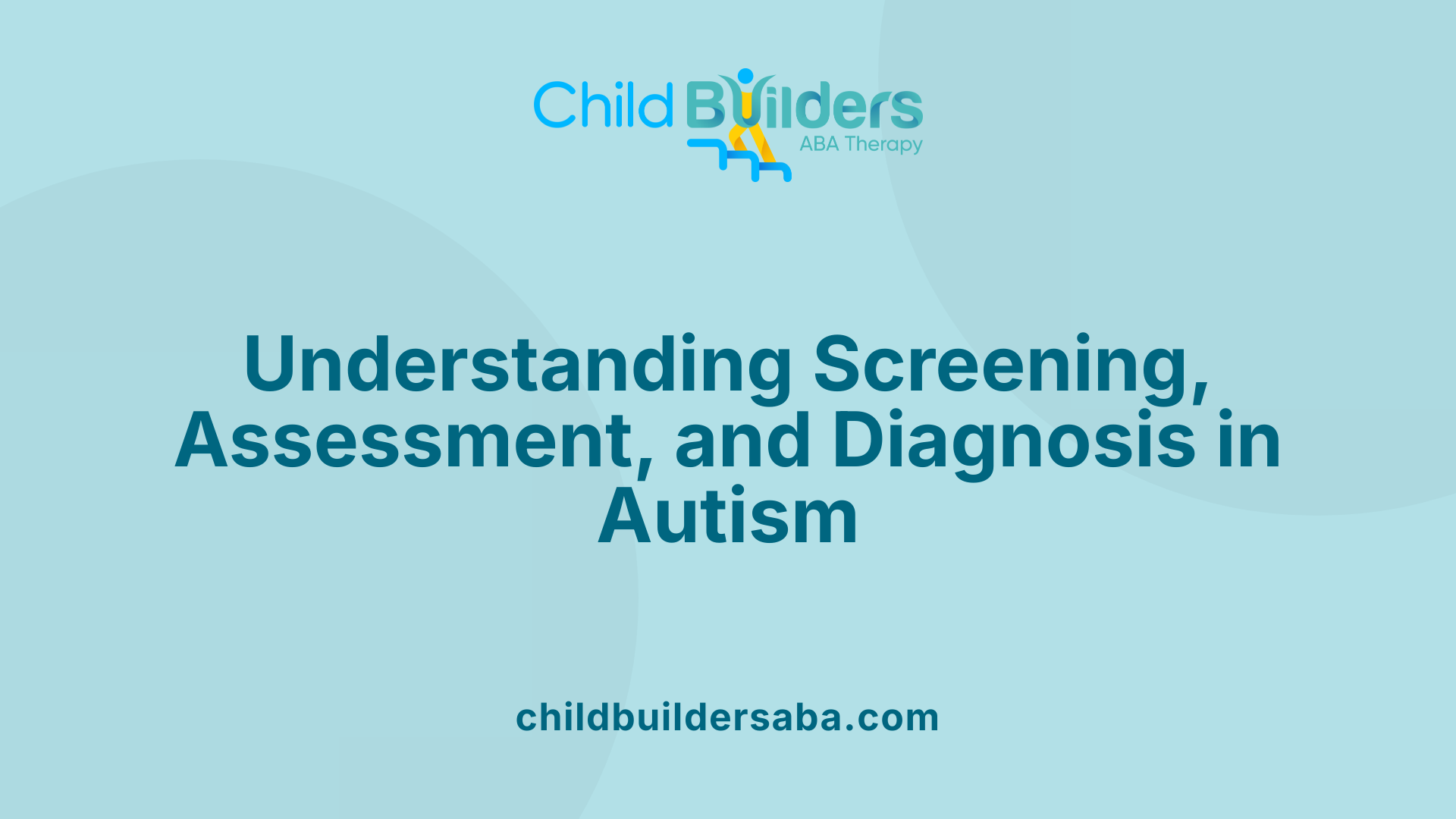 Screening, assessment, and diagnosis are integral steps in identifying autism spectrum disorder (ASD), each serving a different purpose in the diagnostic process.
Screening, assessment, and diagnosis are integral steps in identifying autism spectrum disorder (ASD), each serving a different purpose in the diagnostic process.
Screening is a quick, preliminary way to identify children who may be at risk for autism. It involves brief tools like checklists or questionnaires, such as the Modified Checklist for Autism in Toddlers (M-CHAT), which can be completed by parents, caregivers, or health professionals. These screening tools assess observable behaviors and developmental milestones and are typically used during routine well-child visits at around 18 and 24 months. A positive screening does not confirm autism but indicates that further, more detailed evaluation is necessary.
Assessment is a comprehensive exploration conducted by trained clinicians. This process includes reviewing a child's developmental history, conducting behavioral observations, and using standardized assessments like the Autism Diagnostic Observation Schedule (ADOS-2) and Autism Diagnostic Interview-Revised (ADI-R). The assessment also involves interviews with parents or caregivers to gather detailed information about the child’s communication, social skills, and behaviors. The goal is to gather enough detailed data to understand whether the child meets the criteria for ASD.
Diagnosis is the formal conclusion made by a team of healthcare professionals based on criteria outlined in the DSM-5. It involves analyzing all assessment data to determine whether the child's behaviors and developmental history align with ASD characteristics. This conclusion is essential because it guides intervention planning, support services, and educational planning.
The role of multidisciplinary teams — including psychologists, neurologists, speech therapists, occupational therapists, and pediatricians — is vital in diagnosing ASD. Their collaborative approach ensures a well-rounded understanding of the child's needs and confirms the diagnosis accurately.
Completing all the steps—screening, assessment, and diagnosis—is crucial to avoid misdiagnosis or delayed intervention. While screening helps identify children who need further evaluation early on, assessment and diagnosis are necessary to confirm autism and tailor appropriate support strategies.
| Step | Description | Purpose | Tools Used |
|---|---|---|---|
| Screening | Brief questionnaires like M-CHAT | Early risk detection | Checklists, parental questionnaires |
| Assessment | In-depth review including observations and standardized tests | Detailed understanding of development | ADOS-2, interviews, cognitive testing |
| Diagnosis | Formal determination based on DSM-5 criteria | Confirming ASD diagnosis for intervention | Clinical judgment, assessment report |
Understanding these stages helps parents and caregivers recognize the importance of each step and ensures children receive accurate diagnoses and appropriate support.
The Importance of Early Identification and Intervention
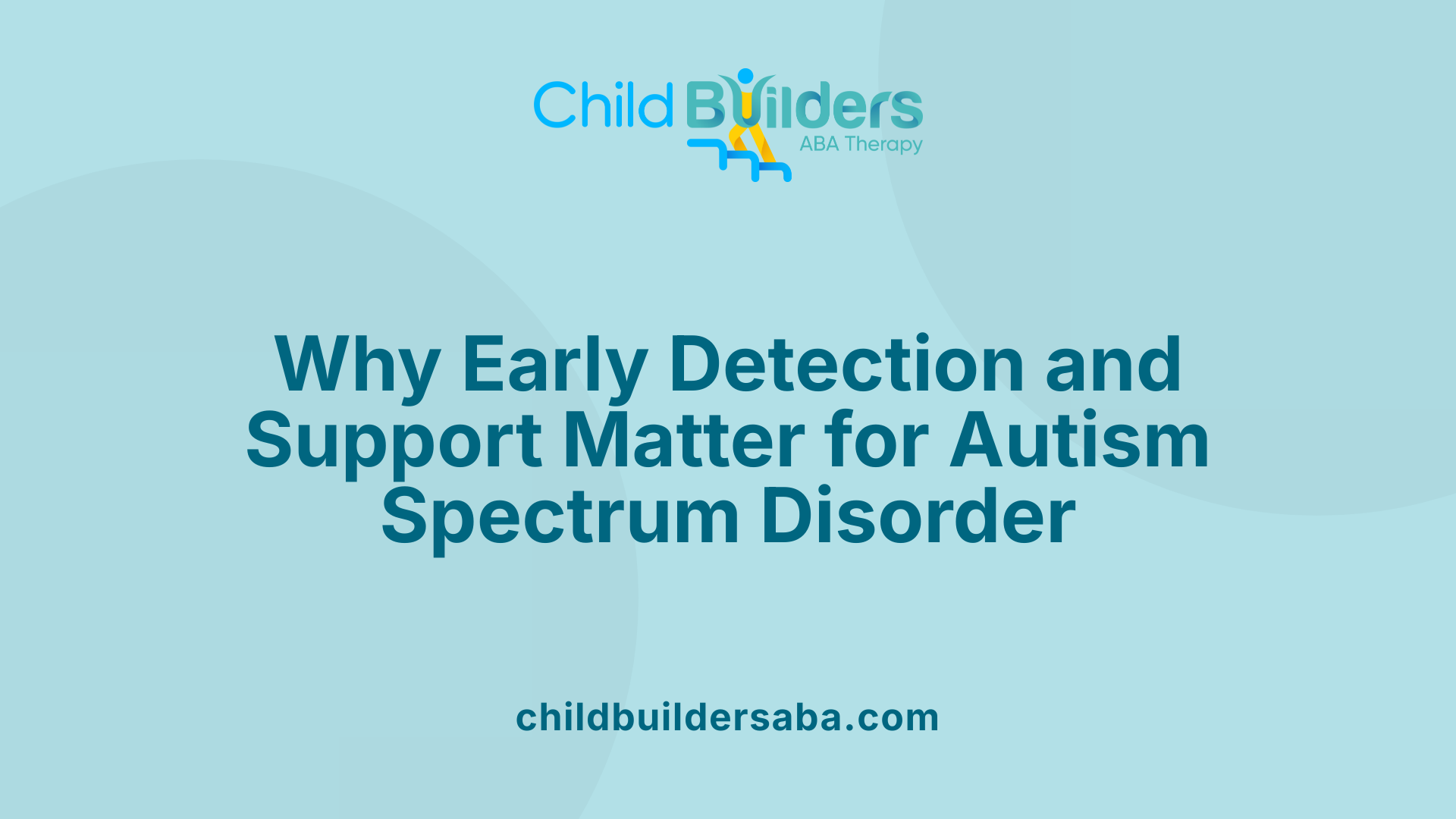
Why is early identification and intervention important in autism spectrum disorder?
Early detection of autism spectrum disorder (ASD) is vital because it opens the door to timely support during crucial periods of brain development. The first few years of life are especially sensitive for learning social, communication, and behavioral skills.
Research indicates that starting therapies like speech, occupational, and applied behavior analysis as early as possible—often before age 3—can dramatically improve outcomes. Interventions initiated around 36 to 47 months have been shown to reduce autism symptoms and enhance a child's ability to communicate, connect socially, and adapt to daily routines.
Early diagnosis also benefits families by providing access to specialized resources and support networks. This helps reduce parental stress and equips caregivers with strategies to foster their child's development.
Long-term benefits include increased chances of independence, better social integration, and an overall higher quality of life. These early efforts lay a foundation that can help some children diminish autism traits or even no longer meet diagnostic criteria. In essence, early identification and intervention are crucial for maximizing each child's potential and ensuring they lead fulfilling lives.
Variability and Age-Dependent Manifestations of Autism
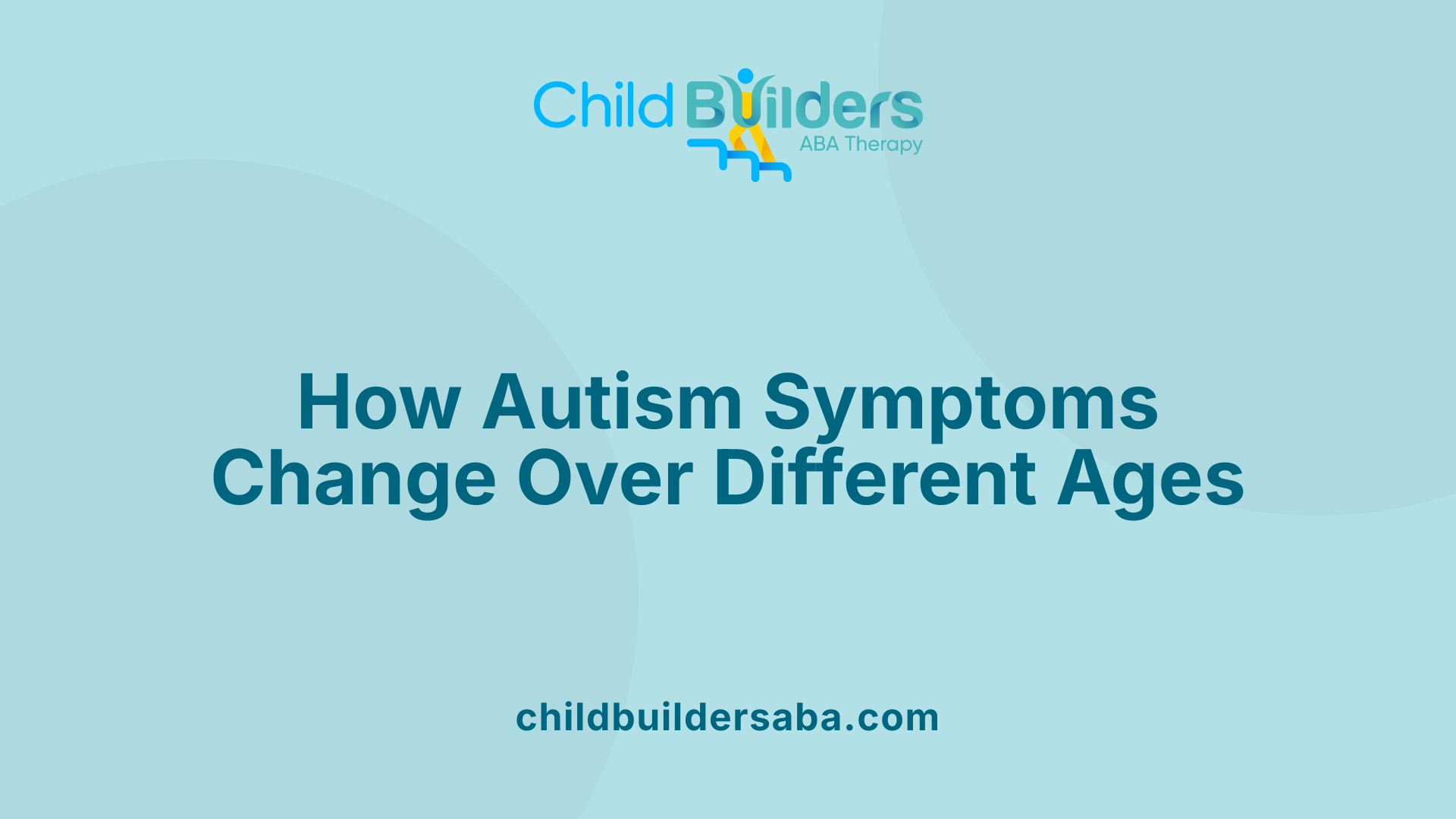
How do autism symptoms differ across various age groups?
Autism spectrum disorder (ASD) displays a wide range of behaviors that change over a person’s lifetime, making age-specific recognition essential.
In infancy, early signs often include limited eye contact, reduced responses to their name, and minimal social smiling. Babies may also show unusual body movements, like hand-flapping or repetitive postures, and might not engage in typical shared attention behaviors such as pointing or waving.
As children grow into toddlers and preschoolers, signs become more Observable. These children may experience speech delays, struggle with language comprehension, or repeat phrases (echolalia). They often have intense interests in specific objects or routines and can be sensitive to sensory stimuli like sounds or textures. Difficulty shifting routines and engaging in pretend play are common.
School-age children with ASD typically demonstrate persistent challenges in social communication. They might understand language literally, avoid eye contact, and prefer solitary activities. It’s common for them to develop intense, narrow interests and exhibit repetitive behaviors. Girls may camouflage their symptoms better, which can delay diagnosis. Difficulties with peer interactions and understanding social cues become more evident.
During adolescence, symptoms often become less obvious or are masked by coping strategies. Anxiety, depression, and social withdrawal are common issues. Teenagers may still struggle with understanding others’ feelings and interpreting sarcasm or idioms. They might prefer routines and show intense focus on particular interests, sometimes at the expense of social engagement.
In adulthood, recognition may occur after many years or during assessments for mental health or employment. Adults often experience ongoing challenges with social relationships, sensory sensitivities, and managing stress. Many learn to mask their symptoms, which can make diagnosis complex. Despite these challenges, many adults with ASD possess strengths such as honesty, focus, and strong reasoning skills.
Overall, these age-related differences highlight the importance of ongoing assessment and tailored support to meet individuals’ evolving needs at each life stage.
| Age Group | Typical Signs | Behavioral Pattern | Notable Variations |
|---|---|---|---|
| Infancy | Limited eye contact, no response to name, rare smiling | Unusual body movements, lack of joint attention | Early red flags, subtle and often overlooked |
| Toddler & Preschool | Speech delays, repetitive speech, sensory sensitivities | Ritualistic routines, fixations on objects | Girls may hide signs better, masking behaviors |
| School Age | Difficulties in social cues, literal language, narrow interests | Repetitive behaviors, social withdrawal | Camouflaging or masking symptoms, especially in girls |
| Adolescence | Anxiety, depression, continued social difficulties | Masking symptoms, focus on routines and interests | Increased risk of mental health challenges |
| Adulthood | Social relationship challenges, sensory overload | Masking, persistence of core symptoms | Recognition often delayed, strengths identified |
Recognizing how ASD symptoms evolve with age helps in providing suitable interventions tailored to developmental stages, improving quality of life across the lifespan.
Dispelling Myths and Misconceptions About Autism
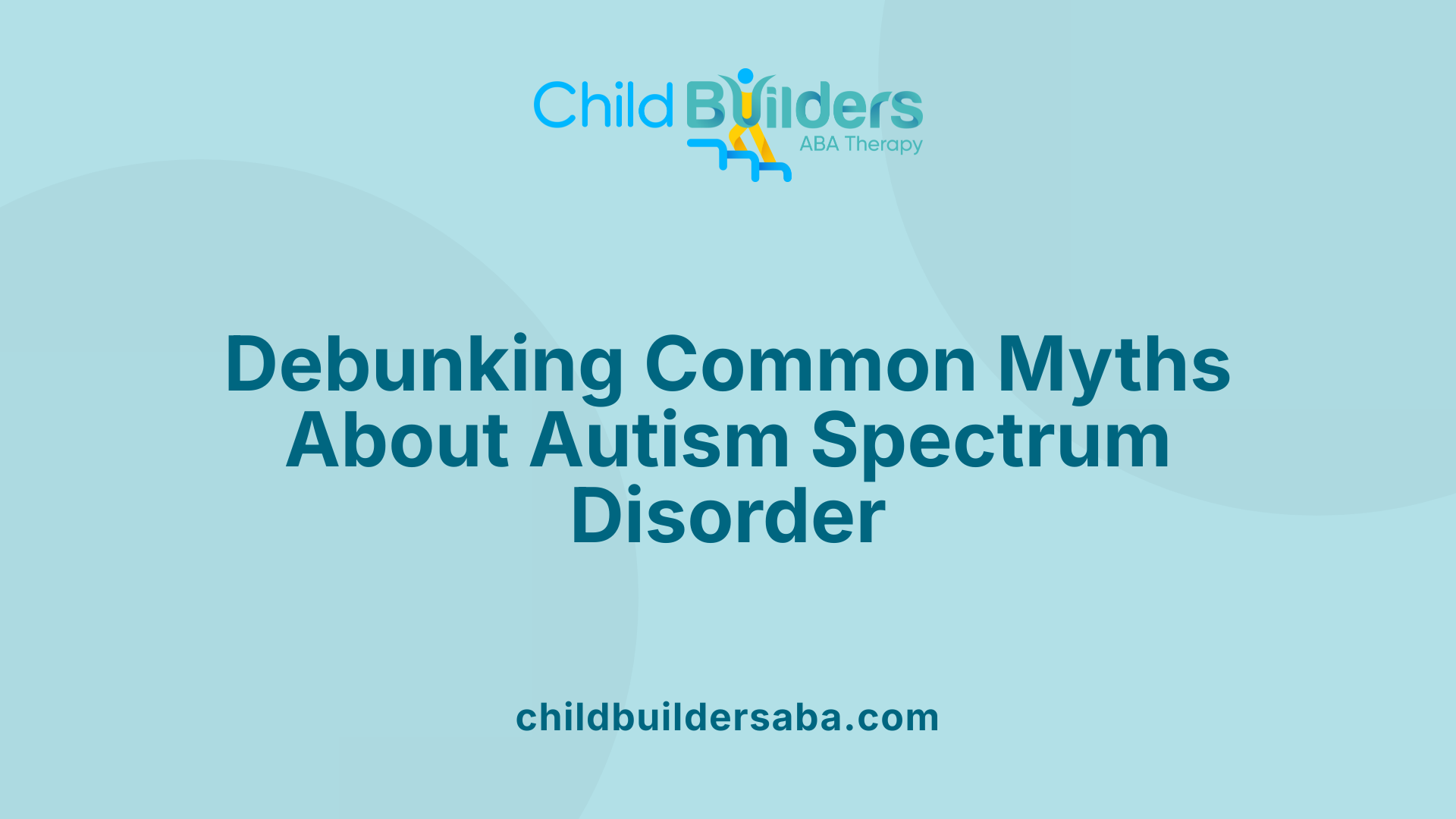
What are common misconceptions about autism that need to be dispelled?
One of the most widespread myths is the false notion that vaccines cause autism. Extensive scientific research has shown no link between vaccinations and the development of autism spectrum disorder (ASD). This misconception has led to unnecessary fears and vaccine hesitancy, but the evidence clearly supports vaccine safety.
Many people also mistakenly believe that autism always presents as severe or that those on the spectrum cannot communicate or build relationships. In reality, autism is a spectrum, meaning its traits and abilities vary widely from person to person. Some individuals are highly verbal and functioning well academically, while others may have significant communication difficulties or intellectual disabilities.
Another misconception involves parenting styles—some think that poor parenting or specific parenting techniques cause autism. This is false; autism is a neurodevelopmental condition influenced mainly by genetics and brain development, not parenting practices.
Many also assume autism can be cured or that it is just a childhood condition. However, autism is lifelong. Early intervention and support can greatly improve the quality of life and help individuals develop skills, but there is no cure for autism itself.
Lastly, stereotypes such as all autistic individuals having extraordinary talents or being violent are inaccurate. Each person with autism is unique with their own strengths, challenges, and behaviors. Recognizing and understanding this diversity is crucial to providing appropriate support and acceptance.
Understanding these facts helps dispel myths, promotes acceptance, and encourages early support for individuals on the autism spectrum.
The Path Forward: Support, Awareness, and Acceptance
Recognizing the signs of autism early is essential for accessing timely intervention that can dramatically influence a child's developmental trajectory. While autism presents differently across various ages and individuals, understanding its core characteristics—social communication challenges, restricted behaviors, and sensory sensitivities—empowers parents to seek appropriate evaluations. Utilizing screening tools like the M-CHAT, consulting healthcare professionals, and collaborating with specialists are crucial steps in confirming a diagnosis. Early diagnosis paves the way for tailored therapies, educational programs, and supportive services that enhance abilities and foster independence. Dispelling myths and promoting awareness ensures a more inclusive and understanding society. As research advances and awareness grows, families and communities can better support children with autism, helping them lead fulfilling lives and reach their full potential.
References
- Could my child have autism spectrum disorder? - Mayo Clinic Health ...
- Signs of autism in children - NHS
- Signs that a child or adult may be autistic
- Autism spectrum disorder - Symptoms and causes - Mayo Clinic
- Early Signs of Autism - UCSD Neurosciences
- Autism Test for Kids and Teens - Child Mind Institute
- Signs and Symptoms of Autism Spectrum Disorder - CDC
- Modified Checklist for Autism in Toddlers, Revised (M-CHAT-R™)
- Autism Spectrum Disorder (ASD) Symptoms & Causes
- Does My Child Have Autism? - HelpGuide.org





.jpg)































































































